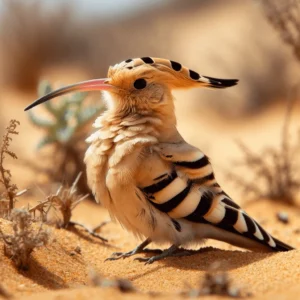Have you ever heard of the Greater Hoopoe-Lark? If not, you are in for a treat! This extraordinary bird is not well-known to the public, but it is a true marvel of nature. In this ultimate guide, we will delve into the world of the Greater Hoopoe-Lark, learning about its habitat, behavior, and how to spot this elusive creature in the wild.
The Greater Hoopoe-Lark is a fascinating bird that is often overlooked by birdwatchers. Its distinctive appearance, unique feeding strategies, and elaborate courtship displays make it a remarkable species to observe in the wild.
You can increase your chances of spotting this elusive bird by researching its habitat, learning its vocalizations, and practicing patience. Stay tuned for the second part of this ultimate guide, where we will explore more about the conservation status and efforts being made to protect this magnificent bird.

Conservation Efforts for the Greater Hoopoe-Lark
Conservation of the Greater Hoopoe-Lark is of utmost importance because its range and habitat are susceptible to human activities and environmental changes. Efforts are being made by local communities, conservation organizations, and government agencies to protect this magnificent bird and its habitat.

Key Takeaways
- Distinctive Appearance: Greater Hoopoe Larks are notable for their long, down-curved bills and sandy, earth-toned plumage, making them a unique sight in their desert habitats.
- Habitat Preferences: These birds are predominantly found in arid, desert-like environments, including in North Africa, the Middle East, and parts of Asia, where they blend seamlessly into the sandy surroundings.
- Varied Diet: Greater Hoopoe Larks primarily feed on insects and small invertebrates, skillfully using their long bills to probe into the sand and soil.
- Complex Mating Displays: The species is known for its elaborate mating rituals, with males performing impressive songs and distinctive, butterfly-like flights to attract mates.
- Remarkable Vocal Abilities: They exhibit a wide range of complex and melodious songs, which include mimicking other bird species and even mechanical sounds.
- Adaptation to Harsh Environments: Greater Hoopoe Larks have evolved several adaptations to survive in the harsh desert conditions, including obtaining moisture from their food and having cryptic coloration for camouflage.
- Conservation Status: While not currently at high risk of extinction, they face threats from habitat destruction and environmental changes, making conservation efforts important for their long-term survival.
- Scientific Interest: Due to their unique adaptations to desert life and complex vocalizations, Greater Hoopoe Larks are a subject of interest in ongoing ornithological and ecological research.
The Habitat and Range of the Greater Hoopoe-Lark
The Greater Hoopoe Lark, scientifically known as Alaemon alaudipes, is a species of lark that can be found across the sandy deserts, steppes, and semi-arid regions of northern Africa, the Middle East, and Central Asia. This bird has adapted to thrive in arid and harsh environments, making it a remarkable species.
The Greater Hoopoe Lark is known for its distinctive appearance. It has a striking black and white plumage with a slightly curved beak. Its overall coloration helps it blend in with the sandy surroundings, offering excellent camouflage against would-be predators.
Because of its extensive range, the Greater Hoopoe Lark has developed several diverse subspecies, each with slight variations in their appearance and behavior. These subspecies include the Arabian Hoopoe-Lark, Baluchistan Hoopoe-Lark, and Mongolian Hoopoe-Lark.
Understanding the Behavior of the Greater Hoopoe-Lark
The Greater Hoopoe is primarily a ground-dwelling bird that spends significant time foraging for food on the sandy desert floor. Its unique feeding strategy uses its long beak to probe the sand for insects, seeds, and other small invertebrates. This bird is particularly skilled at capturing its prey, using its beak like a precision tool.
During the breeding season, the Greater Hoopoe engages in intricate courtship displays. The male bird performs an elaborate song and dance routine, fluffing its feathers and puffing out its chest to attract a mate. These displays are visually captivating and serve as a way for the male to establish its territory and assert its dominance.
The nesting habits of the Greater Hoopoe Lark are equally fascinating. This bird constructs its nest on the ground, typically using small twigs, leaves, and feathers. The female usually lays around 3–4 eggs, which are then incubated by both parents. Once the chicks hatch, both parents take turns caring for and feeding the young until they are ready to venture out on their own.
Spotting the Greater Hoopoe Lark in the Wild
Spotting the Greater Hoopoe Lark in the wild can be a thrilling and rewarding experience for any bird enthusiast. To increase your chances of spotting this elusive bird, it’s important to keep a few things in mind:
1. Research the habit:
Before heading out, ensure you are familiar with the preferred habitat of the Greater Hoopoe Lark. They are most commonly found in open and arid areas, such as deserts, semi-arid steppes, and scrublands.
2. Look for distinctive characteristics.
The Greater Hoopoe-Lark has a unique appearance with its black and white plumage. Look for a medium-sized bird with a long, slightly curved beak. Its distinctive coloration helps it blend in with the sandy environment.
3. Listen for vocalizations:
Although the Greater Hoopoe-Lark is not known for its melodious song, it does have a distinct call. Familiarize yourself with its vocalizations before going birdwatching to increase your chances of identifying this bird by sound.
4. Be patient and observant.
Spotting the Greater Hoopoe-Lark may require some patience and keen observation. Spend time scanning the ground for any movement or signs of bird activity. Look for tracks or disturbances in the sand that may indicate the presence of this fascinating bird.
Following these tips and remaining persistent, you may get lucky and glimpse the Greater Hoopoe-Lark in its natural habitat.
Threats to the Greater Hoopoe-Lark
1. Habitat Loss:
Human activities constantly threatened the Greater Hoopoe-Lark’s preferred habitat of sandy deserts and semi-arid regions, such as urbanization, agriculture, and industrial development. As these habitats are destroyed or degraded, the bird’s population declines.
2. Climate Change:
Climate change is a significant threat to the survival of the Greater Hoopoe Lark. The increase in temperatures and changes in rainfall patterns affect the availability of suitable habitats and the food sources on which the bird relies.
3. Livestock Grazing:
Uncontrolled livestock grazing can lead to habitat degradation and the loss of suitable bird-foraging grounds. Overgrazing can result in decreased vegetation cover, which affects the availability of insects and seeds the Greater Hoopoe Lark feeds on.
Conservation Measures
1. Protected Areas:
The establishment of protected areas has been crucial for the conservation of the Greater Hoopoe Lark. These areas provide a haven for the bird and its habitat, ensuring they are not subjected to destructive human activities.
2. Habitat Restoration:
Efforts are being made to restore and rehabilitate degraded habitats for the Greater Hoopoe Lark. These initiatives involve removing invasive species, re-establishing native vegetation, and creating suitable bird nesting sites.
3. Community Engagement:
Engaging local communities in conservation efforts is essential for the long-term success of protecting the Greater Hoopoe Lark. Educating and involving communities in sustainable land management practices and raising awareness about the bird’s importance can lead to better protection of its habitat.
4. Research and monitoring:
Continuous research and monitoring of the Greater Hoopoe Lark populations help understand their habitat requirements, breeding behaviors, and migration patterns. This knowledge is crucial for implementing effective conservation strategies.
5. International Cooperation:
Collaboration between countries along the migratory routes of the Greater Hoopoe Lark is necessary for the bird’s conservation. Joint efforts in protecting and managing transboundary habitats ensure the bird’s survival and promote international biodiversity conservation.
Conclusion
The Greater Hoopoe-Lark’s unique characteristics and role in ecosystems make it a bird worth protecting. Conservation efforts aimed at preserving its habitats and raising awareness about its importance are crucial for the survival of this remarkable species. By supporting these initiatives, we can contribute to the long-term preservation of the Greater Hoopoe-Lark and other endangered species in our fragile ecosystems.
